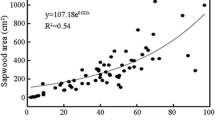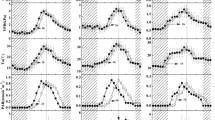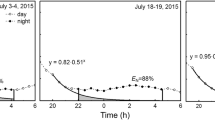Abstract
Extensive research has found that nighttime transpiration (E n) is positively correlated to the vapour pressure deficit (VPD), that suggested E n was highest during the night under high temperatures and low humidity along with high soil water availability, typically for the riparian forest in the extreme arid region of China. This study used the heat ratio method to measure sap velocity (V s) for mature and saplings Populus euphratica Oliv., and then E n was conservatively calculated as total nocturnal sap flow (F s, the product of V s and sapwood area A s) between 01:00 to 06:00. A gas exchange system was used to measure the leaf transpiration rate (T r) and stomatal conductance (g s) of saplings. For mature trees, nighttime V s was extensive and logarithmic correlated to VPD (similar to daytime). For saplings, g s and T r was extensive in different months, and also a strong logarithmic relationship was found between V s and VPD for both daytime and nighttime periods. Both of stem sap flow and leaf gas exchange suggusted the occurrence of E n, whether mature or sapling trees. E n contribution to daily transpiration (E d) was high just as expected for P. euphratica, which was confirmed by proportional E n to E d (E n/E d) means taken in 2012 (24.99%) and 2013 (34.08%). Compared to mature trees, E n/E d of saplings in 2013 was lower with means of 12.06%, that supported further by the shorter duration times and less T r,n (16.64%) and g s,n (26.45%) of leaf, suggesting that E n magnitude is associated to individual the tree size, that effect to stored water of individual trees, although this hypothesis requires further research.
Similar content being viewed by others
References
Alvarado-Barrientos MS, Holwerda F, Geissert DR, Muñoz-Villers LE, Gotsch SG, Asbjornsen H, Dawson TE (2014) Nighttime transpiration in a seasonally dry tropical montane cloud forest environment. Trees 29:259–274
Barbeta A, Ogaya R, Peñuelas J (2012) Comparative study of diurnal and nocturnal sap flow of Quercus ilex and Phillyrea latifolia in a Mediterranean holm oak forest in Prades (Catalonia, NE Spain). Trees 26:1651–1659
Barbour MM, Buckley TN (2007) The stomatal response to evaporative demand persists at night in Ricinus communis plants with high nocturnal conductance. Plant Cell Environ 30:711–721
Barbour MM, Cernusak LA, Whitehead D, Griffin KL, Turnbull MH, Tissue DT, Farquhar GD (2005) Nocturnal stomatal conductance and implications for modelling delta 18O of leaf-respired CO2 in temperate tree species. Funct Plant Biol 32:1107–1121
Benyon RG (1999) Nighttime water use in an irrigated Eucalyptus grandis plantation. Tree Physiol 19:853–859
Bucci SJ, Scholz FG, Goldstein G, Meinzer FC, Hinojosa JA, Hoffmann WA, Franco AC (2004) Processes preventing nocturnal equilibration between leaf and soil water potential in tropical savanna woody species. Tree Physiol 24:1119–1127
Burgess SSO, Adams MA, Turner NC, Beverly CR, Ong CK, Khan AAH, Bleby TM (2001) An improved heat pulse method to measure low and reverse rates of sap flow in woody plants. Tree Physiol 21:589–598
Campbell GS, Norman JM (1998) An Introduction to Environmental Biophysics. Springer, Verlag New York, Inc.
Caird MA, Richards JH, Donovan LA (2007) Nighttime stomatal conductance and transpiration in C3 and C4 plants. Plant Physiol 143:4–10
Cavender-Bares J, Sack L, Savage J (2007) Atmospheric and soil drought reduce nocturnal conductance in live oaks. Tree physiol 27:611–620
Christman MA, Donovan LA, Richards JH (2009) Magnitude of nighttime transpiration does not affect plant growth or nutrition in well-watered Arabidopsis. Physiol Plantarum 136:264–273
Daley MJ, Phillips NG (2006) Interspecific variation in nighttime transpiration and stomatal conductance in a mixed New England deciduous forest. Tree Physiol 26:411–419
Dawson TE, Burgess SSO, Tu KP, Oliveira RS, Santiago LS, Fisher JB, Simonin KA, Ambrose AR (2007) Nighttime transpiration in woody plants from contrasting ecosystems. Tree Physiol 27:561–575
Domec JC, Ogee J, Noormets A, Jouangy J, Gavazzi M, Treasure E, Sun G, McNulty SG, King JS (2012) Interactive effects of nocturnal transpiration and climate change on the root hydraulic redistribution and carbon and water budgets of southern United States pine plantations. Tree Physiol 32:707–723
Donovan LA, Richards JH, Linton MJ (2003) Magnitude and mechanisms of disequilibrium between predawn plant and soil water potentials. Ecology 84:463–470
Fisher JB, Baldocchi DD, Misson L, Dawson TE, Goldstein AH (2007) What the towers don’t see at night: nocturnal sap flow in trees and shrubs at two AmeriFlux sites in California. Tree Physiol 27:597–610
Goldstein G, Meinzer FC, Bucci SJ, Scholz FG, Franco AC, Hoffmann WA (2008) Water economy of Neotropical savanna trees: six paradigms revisited. Tree Physiol 28:395–404
Hogg EH, Hurdle PA (1997) Sap flow in trembling aspen implications for stomatal responses to vapor pressure deficit. Tree Physiol 17:501–509
Howard AR, van Iersel MW, Richards JH, Donovan LA (2009) Night-time transpiration can decrease hydraulic redistribution. Plant Cell Environ 32:1060–1070
Ludwig F, Jewitt RA, Donovan LA (2006) Nutrient and water addition effects on day-and night-time conductance and transpiration in a C3 desert annual. Oecologia 148:219–225
Moore GW, Cleverly JR, Owens M, K. (2008) Nocturnal transpiration in riparian Tamarix thickets authenticated by sap flux, eddy covariance and leaf gas exchange measurements. Tree Physiol 28:521–528
Neumann RB, Cardon ZG (2012) The magnitude of hydraulic redistribution by plant roots: a review and synthesis of empirical and modeling studies. New Phytol 194:337–352
Novick KA, Oren R, Stoy PC, Siqueira MBS, Katul GG (2009) Nocturnal evapotranspiration in eddy-covariance records from three co-located ecosystems in the Southeastern U.S.: Implications for annual fluxes. Agr Forest Meteorol 149:1491–1504
Ogle K, Lucas RW, Bentley LP, Cable JM, Barron-Gafford GA, Griffith A, Ignace D, Jenerette GD, Tyler A, Huxman TE, Loik ME, Smith SD, Tissue DT (2012) Differential daytime and night-time stomatal behavior in plants from North American deserts. New Phytol 194:464–476
Oren R, Sperry JS, Ewers BE, Pataki DE, Phillips N, Megonigal JP (2001) Sensitivity of mean canopy stomatal conductance to vapor pressure deficit in a flooded Taxodium distichum L.forest: hydraulic and non-hydraulic effects. Oecologia 126:21–29
Peng S, Piao S, Ciais P, Myneni RB, Chen A, Chevallier F, Dolman AJ, Janssens IA, Penuelas J, Zhang G, Vicca S, Wan S, Wang S, Zeng H (2013) Asymmetric effects of daytime and night-time warming on Northern Hemisphere vegetation. Nature 501:88–92
Pfautsch S, Keitel C, Turnbull TL, Braimbridge MJ, Wright TE, Simpson RR, O’Brien JA, Adams MA (2011) Diurnal patterns of water use in Eucalyptus victrix indicate pronounced desiccationrehydration cycles despite unlimited water supply. Tree Physiol 31:1041–1051
Phillips NG, Lewis JD, Logan BA, Tissue DT (2010) Inter-and intraspecific variation in nocturnal water transport in Eucalyptus. Tree Physiol 30:586–596
Phillips NG, Ryan MG, Bond BJ, McDowell NG, Hinckley TM, ÈERMÁK J (2003) Reliance on stored water increases with tree size in three species in the Pacific Northwest. Tree Physiol 23:237–245
Rosado BHP, Oliveira RS, Joly CA, Aidar MPM, Burgess SSO (2012) Diversity in nighttime transpiration behavior of woody species of the Atlantic Rain Forest, Brazil. Agr Forest Meteorol 58:13–20
Si JH, Feng Q, Yu TF, Zhao CY (2015) Nighttime sap flow and its driving forces for Populuseuphratica in a desert riparian forest, Northwest, China. J Arid Land 7:665–674
Snyder KA, Richards JH, Donovan LA (2003) Night-time conductance in C3 and C4 species: do plants lose water at night? J Exp Bot 54:861–865
Yu T, Feng Q, Si J, Xi H, Li Z, Chen A (2013) Hydraulic redistribution of soil water by roots of two desert riparian phreatophytes in northwest China’s extremely arid region. Plant Soil 372:297–308
Zeppel M, Logan BA, Lewis JD, Phillips NG, Tissue DT (2013) Why lose water at night Disentangling the mystery of nocturnal sap flow, transpiration and stomatal conductance–When, Where, Who? In IX International Workshop on Sap Flow 991:307–312
Zeppel M, Tissue D, Taylor D, Macinnis-Ng C, Eamus D (2010) Rates of nocturnal transpiration in two evergreen temperate woodland species with differing water-use strategies. Tree Physiol 30:988–1000
Zeppel MJ, Lewis JD, Chaszar B, Smith RA, Medlyn BE, Huxman TE, Tissue DT (2012) Nocturnal stomatal conductance responses to rising [CO2], temperature and drought. New Phytol 193:929–938
Zeppel MJ, Lewis JD, Medlyn B, Barton CV, Duursma RA, Eamus D, Adams MA, Phillips N, Ellsworth DS, Forster MA, Tissue DT (2011) Interactive effects of elevated CO2 and drought on nocturnal water fluxes in Eucalyptus saligna. Tree Physiol 31:932–944
Zhu GF, Li X, Su YH, Huang CL (2010) Parameterization of a coupled CO2 and H2O gas exchange model at the leaf scale of Populus euphratica. Hydrol Earth Syst Sc 14:419–431
Author information
Authors and Affiliations
Corresponding author
Rights and permissions
About this article
Cite this article
Yu, T., Feng, Q., Si, J. et al. Evidences and magnitude of nighttime transpiration derived from Populus euphratica in the extreme arid region of China. J. Plant Biol. 59, 648–657 (2016). https://doi.org/10.1007/s12374-015-0536-4
Received:
Accepted:
Published:
Issue Date:
DOI: https://doi.org/10.1007/s12374-015-0536-4




